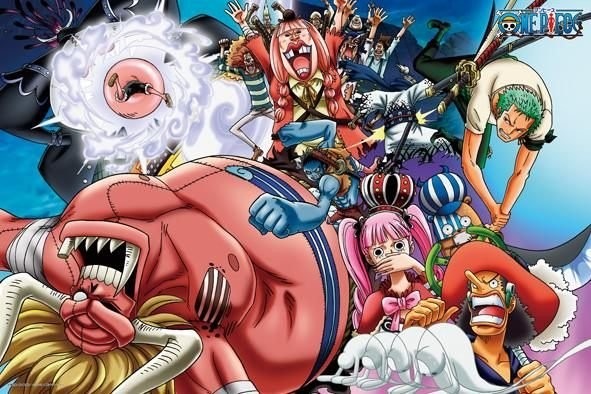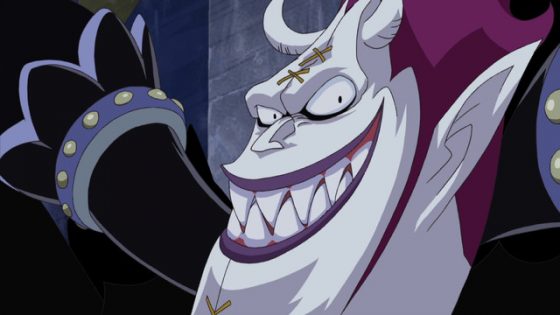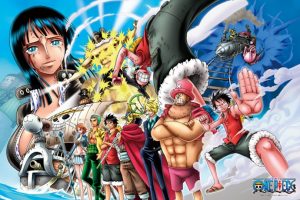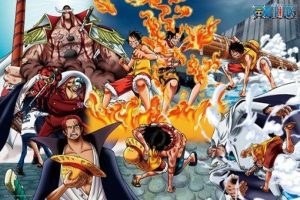
Thriller Bark is a weird arc. Outside of Gecko Moria’s Shichibukai status, there’s not much to connect Thriller Bark with One Piece’s world events. In fact, if Moria wasn’t stealing shadows to perform experiments that go against the laws of human decency, it’s hard to say anyone would even care about his mad science. Yet, because of this, we’re brought into one more adventure before the halfway point of both the Grand Line and the story.
Let’s take a look at why the Strawhats took this detour to Thriller Bark!
The Power Structure Revisited
If there’s one major flaw with One Piece’s title system to roughly determine power levels, it’s that Luffy beat a Shichibukai far too early in the story. Before Crocodile, our only reference point for the strength of a Shichibukai otherwise was Mihawk, who was so overwhelmingly strong that Zoro couldn’t even touch him when Mihawk was fighting him with a toy. Having the next villain be a Shichibukai upped the sense of tension for the proceeding arc, but this also meant that once Luffy won, the threat of a Shichibukai diminished. Can we even take Mihawk seriously anymore now that Luffy has already beat someone in the same position as him?
Since titles are so important to how we understand strength and character progression in One Piece, Thriller Bark’s main intent, beyond introducing Brooke into the narrative, was to re-establish the Shichibukai as a threat. In order to do this, we see one of the first instances of bounties being used in conjunction with title to instill menace. Not only is Moria a Shichibukai, but he’s also got a bounty of 320,000,000 Berries! That’s 4x what Crocodile was worth! It’s actually not even that much higher than Luffy’s bounty at that point, but it does properly solidify that there are “tiers” of Shichibukai. Crocodile just happened to be one of the weaker ones.
Thriller Bark ups the stakes for the rest of the crew by introducing more fights that they can no longer handle on their own. Robin and Chopper have to tag-team against Dr. Hogback. Sanji can’t seem to get the definitive blow against Absalom and needs Nami to jump in to finish the job. No one person on the crew can actually fight against Zombie Oars so they have to handle the fight as a team and Luffy needs a temporary power boost to at least weaken Oars some. It’s becoming clear that the crew is getting to a point where they can’t handle threats on their own anymore.
Blurred Lines
If Enies Lobby made us reconsider how we look at our heroes within the context of their world, Thriller Bark helps us understand that even the arc’s main villains have a bit more going on underneath their monstrous facade. While One Piece is no stranger to characters with… let’s say “unique” moral codes, the one consistency we’ve seen since the beginning of the series is that whoever Luffy fights is unquestionably evil. The World Government is bad, but we’ve seen nations like Alabasta and Drum Island that understand how the game is played and still throw their backing behind the Strawhats. The Marines are a corrupt organization, but there are still decent people like Smoker and Aokiji who try to do the right thing. However, that doesn’t change how Arlong murdered Nami’s mother in front of her and put her into servitude under him, that Rob Lucci enjoyed using justice as a convenient excuse for being excessively cruel, or that Crocodile upended an entire country just so he could find some clues to find a super weapon that would help him conquer the seas.
Now let’s take a look at Moria. Sure, he steals people’s shadows, forces them to live in pure darkness lest they be erased from existence, and is repurposing the corpse of a mega giant into his own personal mech. These are all bad things. The art direction of Thriller Bark, with its kitschy 1950s horror theme, is playing up just how cartoonishly evil Moria is to the point that you can’t even take him seriously.
The major difference between Moria and past villains is an added touch of motivation. We never understood why Arlong wanted to conquer the East Blue in the name of Fishmen, why Crocodile wanted that super-weapon so badly, or why Lucci cared so deeply about justice. Yet with Moria, we get a glimpse of why he wants zombies so badly: he became disenfranchised after losing his entire crew fighting against the Yonko Kaido and wants to rebuild with a crew that he won’t care if they die. This is the first time the main enemy has ever given us a reason to be sympathetic towards them. We still dislike him, but his desire to never lose someone he loves is a drive we can relate to as an audience.
In fact, if there’s a major flaw with Thriller Bark, it’s that Moria does not have the charisma as a villain to keep us that invested in the story. One Piece’s greatest strength beyond its mastery of set-up/payoff storytelling is how it connects the personal struggles of a sympathetic character to the goals of the main villain and what they lose if the main villain succeeds. During Thriller Bark, that character is Brooke, but his goals and Moria’s are entirely unrelated to one another. Nami’s hatred of Arlong felt entirely justified because she lost her one support system in the world. While Robin and Rob Lucci had never met, you can see how Rob Lucci’s mentality of justice at all costs has been pushed by the World Government and how that has affected her life. The most Moria has done is steal Brooke’s shadow and temporarily put a halt to his goals. There’s not much narrative connection between how the two operate. The ending with Kuma jumping into the fray after the defeat of Moria ends up overshadowing the main fight.
Final Thoughts

Thriller Bark is the last arc before we really jump into the main plot of One Piece. It’s there largely to do some last minute work with setting up our expectations, as well as get our final Straw Hat on the crew.
So then, finally, we’ll reach what is inarguably the most important arc of One Piece: Paramount War.
Recommended Post
Looking Back on One Piece: Enies Lobby
Recommended Post



